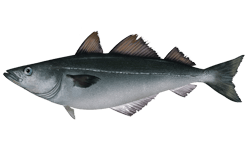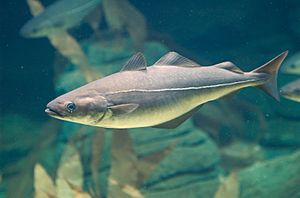Saithe facts for kids
Quick facts for kids Saithe |
|
|---|---|
 |
|
 |
|
| Conservation status | |
| Scientific classification | |
| Synonyms | |
|
The saithe (Pollachius virens) is a type of ocean fish. It belongs to the Pollachius group of fish. In the United States, it is often called pollock, just like another fish, Pollachius pollachius.
Other names for the saithe include Boston blue, coalfish, or coley. In the UK, young saithe are sometimes called podleys in Scotland and northern England.
Contents
What Does a Saithe Look Like?
You can tell the saithe apart from its close relative, P. pollachius, by looking at their jaws. The P. pollachius has a lower jaw that sticks out more than its upper jaw. The saithe, P. virens, has upper and lower jaws that are about the same length. This difference gives each fish a unique head shape.
Saithe are usually bright silver with a very dark green back. In contrast, P. pollachius is often brown or golden with a dark back. Saithe also tend to have slightly smaller eyes. Another way to tell them apart is by their lateral line (a sensory line along the side of a fish). The saithe's lateral line is straighter, while the P. pollachius's has a noticeable bend near its fins.
The meat of the saithe, especially when fresh and uncooked, is dark. This dark color is why it's sometimes called "coalfish." This might have made some people think it wasn't good to eat, but it is!
Where Do Saithe Live and How Big Do They Get?
Saithe are common in the northern parts of the Atlantic Ocean. You can find them in places like the Bay of Biscay. Adult saithe usually live for 16 to 20 years. They can grow to be about 100 to 120 centimeters (about 3 to 4 feet) long.
Some saithe have been caught that were even bigger, up to 130 centimeters (over 4 feet) long and weighing as much as 32 kilograms (about 70 pounds). Young saithe often stay close to the shore, especially in rocky areas. As they get older and bigger, they move into deeper waters. The largest saithe ever caught by a sport fisher weighed 22.7 kilograms (50 pounds). It was caught in Saltstraumen, Norway.
Scientists in Norway have seen saithe gathering around fish farms. They feed on leftover salmon food that escapes through the nets of the farm cages.
Saithe Reproduction and Life Cycle
Saithe become ready to have babies when they are between 4 and 9 years old. Female saithe can lay many eggs. Depending on their size, they can produce anywhere from 500,000 to 9 million eggs. Each egg is very small, only about 1.0 to 1.3 millimeters wide.
How Saithe Are Fished
Saithe are caught all year round. Fishers use different types of equipment, such as Danish seine nets, trawlers, long lines, and gill nets. They are often caught along with other bottom-dwelling fish like cod and whiting.
The main areas for catching saithe in the eastern Atlantic Ocean include the Barents Sea, around Iceland, near the Faeroe Islands, and in the North Sea and Celtic Sea. The amount of saithe caught in the eastern Atlantic has been between 300,000 and 700,000 tonnes each year from 1980 to 2017. Experts from the ICES check these fish populations every year. They suggest how much saithe can be caught safely.
In the western Atlantic, saithe are caught by the USA and Canada. The amount caught there has been between 5,000 and 20,000 tonnes per year from 1980 to 2017. The NOAA checks these fish populations. Many saithe fisheries are certified as sustainable by the Marine Stewardship Council. This means they are caught in a way that helps keep fish populations healthy for the future.
Saithe as Food
Saithe is an edible fish and has commercial value. It is not as expensive as other popular whitefish like cod and haddock. Sometimes, saithe is salted and smoked to make its meat look orange, similar to salmon. In Germany, it is often sold as Seelachs, which means 'sea salmon', even though it is not related to salmon.
Even though a lot of the saithe eaten in Europe are caught in British waters, people in Britain don't eat much of it. Most of the saithe caught by British fishers is sent to France, where it is very popular. Saithe is also used as food for domestic cats.
Images for kids
See also
 In Spanish: Carbonero para niños
In Spanish: Carbonero para niños



